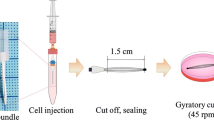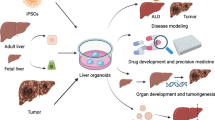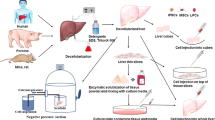Abstract
For further research and application of Bioartificial liver systems (BAL), active proliferation capacity and full hepatic functionality of the biomaterials is mandatory. However, there are still no suitable cell lines meeting the requirements for an ideal cell source in BAL development that makes it necessary to explore other sources. Here, we constructed a new cell line derived from well-differentiated hepatocellular carcinoma tissues designated NHBL2. Immunol staining showed that NHBL2 possessed the capacity of synthesizing albumin and CYP2E1 and quantitative analysis showed that the albumin synthesis ability of NHBL2 was comparable to C3A while urea production was highly abundant of NHBL2 compared with that of C3A. Using gene expression microarray analysis, we found that the expression levels of a set of genes encoding Phase I and Phase II metabolizing enzymes as well as many others related to common bioconversion and metabolic processes were significantly higher in NHBL2 cell line than that in C3A. Moreover, functional optimization assay in Matrigel showed obvious improvements of liver-related function level and a low malignance of this cell line. These findings indicated that NHBL2 possessed relatively attractive and full hepatic functionality that might be a potential cell line for BAL development.





Similar content being viewed by others
References
Benton G, George J, Kleinman HK, Arnaoutova IP (2009) Advancing science and technology via 3D culture on basement membrane matrix. J Cell Physiol 221:18–25
Benton G, Arnaoutova I, George J, Kleinman HK, Koblinski J (2014) Matrigel: from discovery and ECM mimicry to assays and models for cancer research. Adv Drug Deliv Rev 79–80:3–18
Bernhardt AM, Reichenspurner H (2014) High-risk donors: extending our criteria in times of organ shortage. Curr Opin Organ Transplant 19:494–499
Demetriou AA, Brown RJ, Busuttil RW, Fair J, McGuire BM, Rosenthal P, Am EJN, Lerut J, Nyberg SL, Salizzoni M, Fagan EA, de Hemptinne B, Broelsch CE, Muraca M, Salmeron JM, Rabkin JM, Metselaar HJ, Pratt D, De La Mata M, McChesney LP, Everson GT, Lavin PT, Stevens AC, Pitkin Z, Solomon BA (2004) Prospective, randomized, multicenter, controlled trial of a bioartificial liver in treating acute liver failure. Ann Surg 239:667–670
Ellis AJ, Hughes RD, Wendon JA, Dunne J, Langley PG, Kelly JH, Gislason GT, Sussman NL, Williams R (1996) Pilot-controlled trial of the extracorporeal liver assist device in acute liver failure. Hepatology 24:1446–1451
Fernandez SN, Garcia NM, Rivas PJ, Fernandez SC, de Los AVM, Marini MM, Gomez GM (2015) Orthotopic liver transplantation in an adult with biliary atresia, situs inversus, and inferior cava vein absence: a case report. Transplant Proc 47:2407–2409
Guoliang L, Anye Z, Lifu Z, Xiaoping P, Yimin Z, Chengbo Y, Yuemei C, Lanjuan L (2011) Effects of plasma from acute-on-chronic liver failure patients on immortalized human hepatocytes in vitro. Hepatogastroenterology 58:1328–1333
Hu X, Xie P, Li W, Li Z, Shan H (2016) Direct induction of hepatocyte-like cells from immortalized human bone marrow mesenchymal stem cells by overexpression of HNF4alpha. Biochem Biophys Res Commun 478:791–797
Jennen DG, Magkoufopoulou C, Ketelslegers HB, van Herwijnen MH, Kleinjans JC, van Delft JH (2010) Comparison of HepG2 and HepaRG by whole-genome gene expression analysis for the purpose of chemical hazard identification. Toxicol Sci 115:66–79
Lam NT, Lam H, Sturdivant NM, Balachandran K (2017) Fabrication of a matrigel-collagen semi-interpenetrating scaffold for use in dynamic valve interstitial cell culture. Biomed Mater 12:45013
Lee JH, Lee DH, Lee S, Kwon C, Ryu JN, Noh JK, Jang IK, Park HJ, Yoon HH, Park JK, Kim YJ, Kim SK, Lee SK (2017) Functional evaluation of a bioartificial liver support system using immobilized hepatocyte spheroids in a porcine model of acute liver failure. Sci Rep 7:3804
Liu H, You S, Rong Y, Wu Y, Zhu B, Wan Z, Liu W, Mao P, Xin S (2013) Newly established human liver cell line: a potential cell source for the bioartificial liver in the future. Hum Cell 26:155–161
Mavri-Damelin D, Damelin LH, Eaton S, Rees M, Selden C, Hodgson HJ (2008) Cells for bioartificial liver devices: the human hepatoma-derived cell line C3A produces urea but does not detoxify ammonia. Biotechnol Bioeng 99:644–651
Mhaidat NM, Alzoubi KH, Khabour OF, Banihani MN, Al-Balas QA, Swaidan S (2016) GRP78 regulates sensitivity of human colorectal cancer cells to DNA targeting agents. Cytotechnology 68:459–467
Punzalan CS, Barry CT (2015) Acute liver failure: diagnosis and management. J Intensive Care Med. https://doi.org/10.1177/0885066615609271
Sakiyama R, Blau BJ, Miki T (2017) Clinical translation of bioartificial liver support systems with human pluripotent stem cell-derived hepatic cells. World J Gastroenterol 23:1974–1979
Saraiva-Pava K, Navabi N, Skoog EC, Linden SK, Oleastro M, Roxo-Rosa M (2015) New NCI-N87-derived human gastric epithelial line after human telomerase catalytic subunit over-expression. World J Gastroenterol 21:6526–6542
Selden C, Chalmers SA, Jones C, Standish R, Quaglia A, Rolando N, Burroughs AK, Rolles K, Dhillon A, Hodgson HJ (2003) Epithelial colonies cultured from human explanted liver in subacute hepatic failure exhibit hepatocyte, biliary epithelial, and stem cell phenotypic markers. Stem Cells 21:624–631
Starokozhko V, Groothuis G (2016) Challenges on the road to a multicellular bioartificial liver. J Tissue Eng Regen Med. https://doi.org/10.1002/term.2385
Takahashi N, Aoyama F, Hiyoshi M, Kataoka H, Sawaguchi A (2014) Establishment and biological characterization of a novel cell line derived from hepatoid adenocarcinoma originated at the ampulla of Vater. Int J Oncol 44:1139–1145
Yang Y, Li J, Pan X, Zhou P, Yu X, Cao H, Wang Y, Li L (2013) Co-culture with mesenchymal stem cells enhances metabolic functions of liver cells in bioartificial liver system. Biotechnol Bioeng 110:958–968
Acknowledgements
This work was supported by Science and Technology Planning Project of Guangdong Province (2014A050503041, 2017A020215046, 2017B02029003), Guangzhou Bioengineering Research Center for Gastroenterology Diseases (7415696196402) and President Foundation of Nanfang Hospital, Southern Medical University (2016C001).
Author information
Authors and Affiliations
Corresponding authors
Ethics declarations
Conflict of interest
The authors declare that there are no conflict of interest.
Rights and permissions
About this article
Cite this article
Yan, Q., Deng, L., Zhao, X. et al. Establishment and characterization of an immortalized human hepatocyte line for the development of bioartificial liver system. Cytotechnology 70, 665–674 (2018). https://doi.org/10.1007/s10616-017-0167-3
Received:
Accepted:
Published:
Issue Date:
DOI: https://doi.org/10.1007/s10616-017-0167-3




